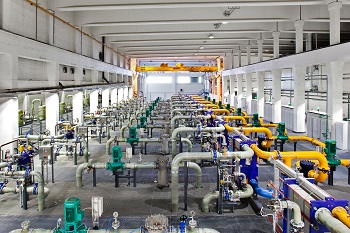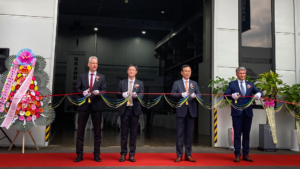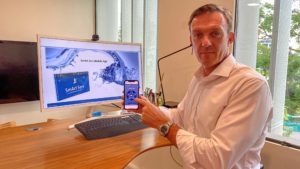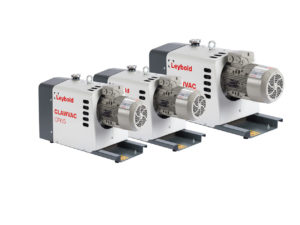Reliable and Eco-Friendly Data Centre Cooling with Wilo Pumps
“Google retains its leading position in building a green Internet”. This title was given to the Internet giant by an organisation no less than Greenpeace.

“Green IT” par excellence: The green pumps of Wilo’s “CronoLine-IL” series contribute to the exemplary efficiency of the Google data centre in Hamina through their high efficiency and low life cycle costs (Image: Google)
The cooling system of one of the latest data centres, built by Google in the Finnish town of Hamina, befits this “green theory of colours”: High-performance pumps by Wilo have been installed for cooling the numerous connected servers in the 9,000 m² complex to their operating temperatures. This is not because they look green, but because they are actually green – from their energy efficiency to their reliability and to their long service life.
Greenpeace laments that many well-known Internet companies only look for the lowest electricity prices when deciding where to set up a new data centre. In contrast, Google chose to do things another way, an eco-friendly way. According to the latest “Clicking Clean” report, in which Greenpeace examines the environmental footprint of 300 of the largest data centres worldwide, Google is also top in the sector in terms of environmental protection. The company has set the long-term goal of using only renewable energies to meet the energy requirement for its data centres. At the same time, it is also taking great efforts to increase the energy efficiency in its data centres, especially for the energy-intensive cooling of the servers.
Google’s choice of locating its newest data centre for Europe in Hamina, Finland, is a testament to this. The decisive factor was not the electricity price, but rather the low average temperature of 2 °C and the location’s proximity to the Finnish sea. There, server cooling is done using cold seawater, saving energy in the process. The Wilo pumps “CronoLine-IL” play a crucial role in making a main node on the global data highway economically and eco-friendly.
A lot of water, little electricity
In 2011, the electricity requirement for data centres worldwide stood at 684 billion kWh. For comparison: The whole of Germany consumed “merely” around 607 billion kWh in the same year. According to forecasts, energy consumption is expected to increase by 63 percent by 2020, driven by cloud computing. Today 22 percent of energy consumption in data centres is attributed to cooling. Water cooling through use of natural resources, as in Hamina, is therefore a vital strategy for improving efficiency. In addition, efficiency criteria are also set high for the pumps used to convey cooling water in the data centre, as can be seen from the Wilo pumps “CronoLine-IL” used there.
To be able to supply the required amount of cooling water, the glanded pumps are installed horizontally as in-line pumps in the piping systems. The pipe sizes of the cooling circuits range from DN 150 to DN 200. The impellers of the pumps have been designed to suit this: they have a nominal diameter of 320 or 270 mm. The specific impeller geometry and a flow-optimised coating play a part in the high overall efficiency. The hydraulic efficiency of the “Wilo-CronoLine-IL” with connection nominal diameter DN 150 is over 80 percent, and the hydraulic efficiency of that with DN 200 more than 70 percent. The motor efficiency is at 94 percent. As a result, a motor nominal power of between 30 and 37 kW is sufficient to pump the volumes required for meeting the cooling loads. Additional energy savings are achieved by the consumption-based pump speed control through a frequency converter.
Reliable and economical operation
The Internet never sleeps. Google answers around 64,000 search queries per second; this number alone shows the high demands that the company has to place on the availability of its data centres. Further, important cloud services for other companies with locations worldwide also require data to be available around the clock. Therefore, besides computing technology, cooling is also a crucial factor for operational reliability. Modern server systems are allowed to operate at temperatures of up to around 35 °C. Without cooling, however, this limit would be exceeded very quickly, bringing everything to a standstill.
In order that the pumps convey cooling water reliably for keeping temperature as constant as possible, Wilo manufactures its pump housing and individual components from highly durable materials. The housing and impeller of the “CronoLine-IL” series of pumps used in the Google data centre are made of, for example, wear-resistant cast iron with flake or spheroidal graphite. To further reduce the pumps’ life cycle costs, the pump lantern is made using a patented design. The design ensures specific removal of the relatively large amounts of condensate formed on the pump housing when a pump is conveying a cold medium at high ambient temperatures. This protects the pumps from typical corrosion damage. In addition, highly wear-resistant mechanical seals made of graphite, silicon carbide, EPDM and stainless steel allow for long maintenance intervals.
Conclusion
“Digitalisation in companies is progressing at a rapid rate. This is of course also true for the home setting – as the term ‘smart home’ proves. At the same time, energy resources are becoming increasingly scarcer. This makes ‘green IT’ ever more important,” says Sven Prochowski (Senior Vice President Group Information Management), recognising the development of data centre cooling from a user’s perspective as well. The IT company Cisco shares this opinion and forecasts a massive growth in Internet usage by 2020: In 2015, “only” 40 percent of the world population had access to Internet; this figure will certainly increase to 52 percent by 2020. At the same time, technological advancement will enable ever larger amounts of data to be transported. In 2015, a user transferred on average 9.9 GB of data per month, but this figure is set to exceed 25 GB by 2020 – a 150 percent increase! “Computer technology is making great leaps and this is evident to most people in their daily lives. Behind the scenes, however, pump technology, which is perceived as a conventional technology, is playing a very important role as well in combining energy efficiency and global networking. And Wilo is contributing to this through its research and development work,” affirms Dr.-Ing. Markus Beukenberg, Chief Technology Officer (CTO) of WILO SE.
Source: WILO SE





